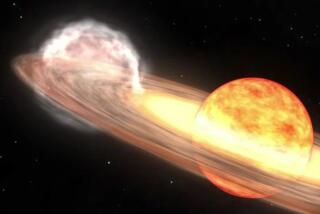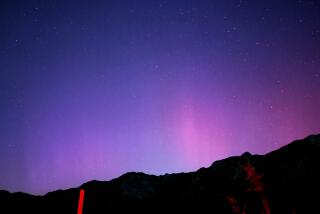SCIENCE NORTHERN LIGHTS : Scientists in Polar Areas Go With Glow
- Share via
TROMSOE, Norway — A geomagnetic storm battering the Earth’s poles is growing increasingly violent, and northern lights researchers call it the best thing that’s ever happened to them.
The storm, caused by the bombardment of energy from solar activity, is making the shimmering aurora borealis brighter, more colorful and more spectacular than usual this year.
Unni Pia Loevhaug, a space researcher, plans to fire bolts of electricity at the ionosphere, the layer of the Earth’s atmosphere that acts like a movie screen for the solar lights, to get an even better picture.
The study should offer insights into the universe and theories of physics and “increase man’s storehouse of knowledge,” she said.
Her work may have practical applications in helping to overcome the havoc that the electrically charged lights can play with radio communications and navigation.
In Tromsoe, 185 miles north of the Arctic Circle, the tourism board is thankful for the aurora borealis, which has drawn the curious and adventurous for hundreds of years.
These amazing sheets of light are the offspring of the solar wind--bursts of energized atomic particles that sweep 93 million miles through space and slam into the Earth’s magnetic field at a speed of 1.56 million m.p.h.
The collision releases the storm of energy seen in the constantly changing lights. Over the South Pole they are called the aurora australis.
“It’s absolutely the most fantastic thing we have up here in the north,” tourist official Gunn Sissel Jaklin said.
“The aurora will just keep getting better and better from now until 1994 because the 11-year solar cycle is moving toward a peak.”
Space researcher Loevhaug keeps tabs on the lights summer and winter, even when they are dimmed or hidden by the midnight sun.
“We’re already seeing things that I have never witnessed before,” she said. She has studied the lights since 1983.
From her laboratory 18 miles outside town, the 33-year-old physicist is taking part in European Incoherent Scatter Radar (EISCAT), a project launched in 1981 to study the northern lights and the Earth’s outer atmosphere.
EISCAT’s studies are funded by Britain, France, West Germany, Norway, Sweden and Finland.
A transmitter fed by five megawatts of power, enough to light a small village, bounces a radar beam off the ionosphere 30 to 1,250 miles above the Earth. Signals are picked up in Sweden and Finland and relayed to Tromsoe.
“A radar wave is an electromagnetic field,” Loevhaug said. “It scatters through the northern lights, and we receive a picture of what is going on. When solar activity builds up, it amplifies the lights and makes our studies easier.”
It took centuries for mankind to discover that solar flares, tongues of fire that leap thousands of miles above the sun’s surface, caused the lights.
The Vikings believed the lights were flashes from the shields of warriors bound for heavenly Valhalla. Eskimos imagined dangerous spirits, while Swedes thought it was the torchlight of Lapps stalking stray reindeer.
Centuries ago, Tromsoe’s people feared that laughing at the northern lights would anger the gods, who would strike them lame.
The aurora has sometimes been seen far south of the Arctic Circle. It was mentioned in the Bible and pondered by Greek philosopher Aristotle 2,500 years ago.
Even though lights are commonly seen in Tromsoe, “a colorful display makes everyone drop what they are doing to watch,” Jaklin, the tourism official, said.
“They look fantastic even when you understand them,” Loevhaug said.






